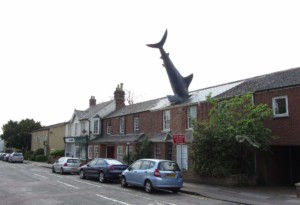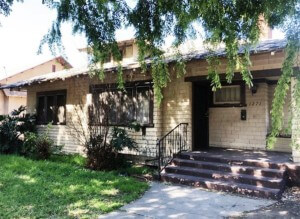This week the New York City Landmarks Preservation Commission (LPC) is holding a public hearing on changes to its rules of operation. Among other modifications, the new rules would allow the agency to move items off its public hearing calendar, a change the LPC says would alleviate pressure on the almost all-volunteer commissioners who meet weekly to debate and vote on new landmarks, as well as changes to historic properties. Many leading preservation groups, however, believe that channeling more items to agency staffers would deprive New Yorkers of the opportunity to meaningfully weigh in on changes to the historic built environment.
Right now, select LPC applicants go through a public hearing, a Tuesday meeting at the LPC’s Manhattan office where architects and owners present their plans to the agency’s 11 commissioners and to the public. These meetings let stakeholders weigh in on small items like the window replacement scheme for a private home in Crown Heights, Brooklyn, and on headline-grabbing proposals like the landmark potential of Philip Johnson and John Burgee’s AT&T Building. Discussions on each item can last twenty minutes or one-and-a-half hours, depending on how controversial the item is or if the commissioners debate the owner’s request vigorously. Other more minor issues, like small storefront build-outs in a landmarked building or railing replacement on a private home in a historic district, get evaluated by LPC staff and approved behind the scenes. The items in public hearings are seeking a Certificate of Appropriateness, while the items processed by staff are awarded either a Certificate of No Effect or a Permit for Minor Work.
The draft of the new rules (PDF) addresses both changes to the public hearing process as well as issues like sidewalk modifications, appropriate materials, and “no style” buildings, to name a few. Together, they cover more nuts-and-bolts preservation issues than can be discussed in a single article, so The Architect’s Newspaper (AN) reached out to preservation leaders to get their take on the key issues the public, especially architects, should watch out for ahead of tomorrow’s hearing on the proposal.
Many leading preservation groups are worried that the proposed rules would silence the public’s voice on changes that have a cumulative impact on the city’s historic fabric. Simeon Bankoff, executive director of preservation advocacy group the Historic Districts Council, was concerned about what he sees as a softening of requirements around materials for repairing and replacing historic building components. After six stories on masonry buildings, for example, the new rules would allow owners to use substitute materials like fiberglass in lieu of original stone or terra-cotta when replacing historic building elements.
“Rather than lowering the standards—which we felt was being done in many cases in these rules—you want to raise them,” Bankoff said. “People are going to build to whatever standard you give them. If the reward is they don’t have to go through a public hearing, they should be held to the highest standards possible.”
Under the new rules, rear yard additions, which can be contentious, would be heard by staff only, provided they met certain requirements. HDC believes that rear-yard addition should go before the public, because neighbors have a right to comment on what is (literally) going on in their backyards.
On the plus side, Bankoff said, the proposal includes “nice language” on the collective impact of rooftop and rear yard additions, as well as signage.
Andrew Berman, executive director of the Greenwich Village Society for Historic Preservation (GVSHP), a leading downtown preservation group, expressed concern that, under the new public hearing rules, more buildings could wind up like Twin Peaks, an unusually proportioned Greenwich Village co-op that that exemplified the neighborhood’s bohemian spirit. The owner got staff approval last year to repaint the structure and its distinctive brown half-timbering beige and dark grey, a move that Berman believes could have been avoided had the public been given a chance to weigh in on the significance of the original contrasting color scheme.
He was blunt about the impact of the changes to the public hearing. “The proposed rules are fundamentally anti-democratic, anti-transparency, and anti–public participation. This is the opposite direction the commission should be moving in.”
Landmark West! Executive Director Sean Khorsandi echoed GVSHP’s concerns. “The New York City landmarks commission has been trendsetters, nationwide and globally,” he said. “The commission is in a league of its own; people have been looking to it to set the standards. We see these proposed changes as a little bit of a backtrack.”
On the Upper West Side, the neighborhood for which Landmark West! advocates, Khorsandi said the new rules would have a substantial impact on current and future landmarks. The rules would allow alterations to features not mentioned in the designation report, a change that would disproportionately impact earlier designations like The Belnord. The apartment complex’s one-page report doesn’t mention the property’s distinctive vault lights, as the LPC used to require short-and-sweet reports on all items, regardless of their size or importance. This leaves historic features on early designations vulnerable to inappropriate changes or outright removal. To ensure sensitive treatment of protected items, Landmark West! would like to see the agency hire more staff, instead of moving items away from public hearings.
Architecture and urbanism advocates at the Municipal Arts Society (MAS) also believe the new rules might unintentionally incentivize removal of these vault lights, among other historic features. Tara Kelly, MAS’s vice president of policy and programs, explained that the group was concerned about the language around “no style” buildings, vague wording that covers structures that are undistinguished or don’t contribute to the look and feel of a historic district. The term originated in the Upper East Side Historic District around three decades ago, but, a “no style” structures of yesteryear might become historically significant years later. Kelly (a former executive director of Friends of the Upper East Side Historic Districts) cited 966 Lexington Avenue, a simple mixed-use building that wasn’t named in the original historic district, but probably would have been included had the district been designated today.
“It takes time to appreciate a new style,” Kelly said. “We want to see the commission take a harder look at those buildings, not make exceptions for them.”
To help the public understand all the changes afoot, MAS has released a set of interactive maps for each category of permit to help the public understand what landmarks currently exist and how they’ve been modified over time.
Unlike other preservation groups AN consulted, however, MAS conditionally supports the changes that would move items out of the public hearings. “As long as these rules are strong, robust, and thoughtful and take into consideration the recommendations that we have for the rules, and the staff is well-trained and well-supported in their ability to execute the regulation, we don’t have a problem with the staff doing so,” Kelly said.
Although the chatter around the changes to the public hearing is loud (especially on preservation Twitter), the new meeting rules would affect relatively few items. A LPC spokesperson said that each year, the vast majority of the approximately 14,000 permit applications are decided by staff, while fewer than 1,000 items get discussed at the public meetings. Right now, the agency has 36 staff members reviewing permits, and they will welcome three new permit-reviewing staffers in fiscal year 2019, which begins in July. Taken together, the number of permit-reviewing staff has increased 44 percent between fiscal years 2013 and 2019. Even so, the increasing number of permit applications places stress on the commissioners at the public hearing—only LPC Chair Meenakshi Srinivasan is paid for her work. The other ten commissioners take time away from their practices as architects and planners to serve in a volunteer capacity on the commission nearly every week. Of the items that go to public hearing, the LPC contends in its summary of the new rules that agency staff could “approve a variety of work-types that are consistently approved by the Commission utilizing established criteria.”
AN spoke with a government insider familiar with the proceedings who confirmed that the changes are intended to save staff time and increase efficiency so LPC staffers can process more applications. Overall, the insider said the intended goal is to make the process easier for homeowners and developers.
The rules changes were a long time coming. Beginning in February 2017, the LPC convened multiple meetings with eight leading preservation groups to discuss the agency’s ideas. A LPC spokesperson confirmed that representatives from the New York Landmarks Conservancy, MAS, the Brooklyn Heights Association, HDC, Society for the Architecture of the City, Friends of the Upper East Side Historic Districts, Landmarks West!, and GVSHP were shown criteria for specific types of work and asked for input on the criteria. As part of its outreach, agency representatives also met with community boards, members of the public, and other preservation groups, as well as AIA New York (AIANY), Urban Green Council, the NY Bar Association, and REBNY. In addition to those groups, LPC staffers solicited input from window manufactures, expeditors, and preservation architects on the rules. The current draft was released in January of this year.
Suzanne Mecs, managing director of AIANY, delivered a statement in support of the rule changes. The organization characterized the public hearings in pursuit of a Certificate of Appropriateness as “a process that can often be expensive, time-consuming, and complicated.” With more items decided on by staff, AIANY believes the public hearing process will improve because, it reasoned, the commission will have more time to focus on “complicated preservation projects with subjective design considerations or innovative technical solutions that do not readily conform to the previously-established criteria of the Commission.” The AIA held a forum on the changes with its members and Srinivasan in early March.
For those who want to weigh in on the rules, the meeting begins tomorrow, March 27, at 9:00 a.m. The agenda and more details can be found here.
Edward Gunts contributed reporting.











